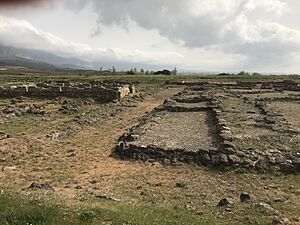La Hoya, Álava facts for kids

View of La Hoya
|
|
| Lua error in Module:Location_map at line 416: Malformed coordinates value. | |
| Location | Laguardia, Álava, Basque Country, Spain |
|---|---|
| Coordinates | Lua error in Module:Coordinates at line 614: attempt to index field 'wikibase' (a nil value). |
| Type | Settlement |
| Area | 5.1 ha (13 acres) |
| History | |
| Founded | 12th century BCE |
| Abandoned | c. 250 BCE |
| Cultures | Celtiberian |
| Site notes | |
| Discovered | 1935 |
| Archaeologists |
|
| Official name | Recinto Arqueológico de la Hoya |
| Type | Non-movable |
| Criteria | Monument |
| Designated | 17 July 1984 |
| Reference no. | RI-51-0005133 |
La Hoya is a very important ancient place in Laguardia, Álava, Basque Country, Spain. It shows us how people lived during the Bronze Age and Iron Age. This fortified town was home to people for about 900 years, from the 12th century BCE to around 250 BCE.
Contents
Life in Ancient La Hoya
Archaeologists have found three main layers at La Hoya. Each layer tells us about a different time period and how the town changed. These layers are like chapters in a history book, built one on top of the other.
Early Bronze Age Life
The earliest period at La Hoya was during the Middle-Late Bronze Age. Back then, the town's defenses and even the houses were all made from wood. This shows that people used the materials they had around them to build their homes and protect their community.
Iron Age Changes
As time moved into the Early-Middle Iron Age, the people of La Hoya started building differently. They used a mix of materials like stone, wood, and adobe (which is like sun-dried mud bricks). Most of the houses during this time were built close to the town's protective wall.
Late Iron Age Advancements
The final period of La Hoya was the Late Iron Age. Some experts believe the culture here was Celtiberian. This era brought big changes to the town's design. Streets were paved, and open areas (plazas) were created, forming a neat, grid-like pattern. The town's wall was also rebuilt using strong stone.
This last period also shows how much technology improved. People started using the potter's wheel to make pottery, and they became very skilled at working with metal, especially blacksmithing.
How La Hoya Became a Tell
Over hundreds of years, old buildings would fall apart or be torn down. The rubble and remains from these old structures were then used as foundations for new buildings. This process happened again and again, causing the ground level of the town to slowly rise. All these layers of old materials created a small hill, about 3 meters (10 feet) high. This kind of archaeological hill is called a tell.
The End of La Hoya
Sadly, the town of La Hoya was violently destroyed sometime between 350 and 200 BCE. When archaeologists dug up the site, they found the remains of people and their everyday items scattered in the streets. This suggests that the destruction happened very suddenly, leaving no time for people to escape or gather their belongings.
See also
 In Spanish: La Hoya (Laguardia) para niños
In Spanish: La Hoya (Laguardia) para niños

